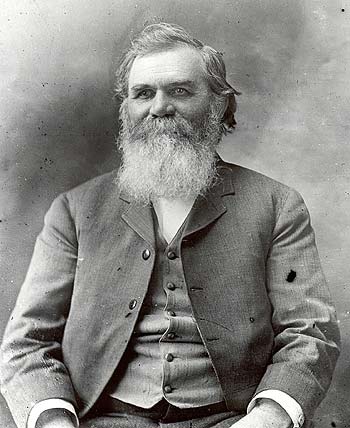History and Origins Of Chiropractic
Origins
Spinal manipulation has been practiced for centuries, with evidence of the practice dating back to the ancient Egyptians. Hippocrates, known as the father of medicine, who lends his name to the Hippocratic Oath that medical doctors adhere to was a proponent of spinal manipulation.
Daniel David (D.D.) Palmer (March 7, 1845 – October 20, 1913), known as the “discoverer of chiropractic” was born in Ontario and emigrated to the U.S. He was practicing magnetic healing in Davenport, Iowa, when on September 18, 1895, Harvey Lillard, a janitor in the Ryan Building where Palmer was practicing, started a conversation with D.D. Palmer. Lillard was very hard of hearing, as he had been for 17 years when “in a stooped position, felt something ‘give way’” in his back. Palmer was an avid reader and interested in all things health-related and was familiar with the concepts of spinal manipulation. He convinced Mr. Lillard to allow him to “rack his bone back into position” and a few days later, Mr. Lillard conveyed to Dr. Palmer that his hearing was almost fully restored. This was the beginning of the practice of Chiropractic.
Over the next two years, D.D. Palmer continued to develop the philosophy, theories and techniques, being the first to use the vertebral spinous process as a “short lever” for the manipulative technique he called the “chiropractic adjustment”.
In 1897, D.D. Palmer opened the Palmer School and Cure (PSC) to train others in this new healing field. One of his early students was his son, Bartlett Joshua (B.J.) Palmer, known as the “developer of chiropractic”.
B.J. Palmer took the reins of the young school in 1906 and in 1907, incorporated it and changed the name to the Palmer School of Chiropractic. B.J. Palmer made it his mission to bring chiropractic to the masses, often quoted as saying, “I will sell Chiropractic, serve Chiropractic, and save Chiropractic if it will take me twenty lifetimes to do it. I will promote it within the law, without the law, in keeping with the law or against the law in order to get sick people well and keep the well from getting sick.” Over the course of his 55 years as head of the Palmer School of Chiropractic, B.J. developed many techniques for chiropractic practice, as well as multiple diagnostic tools such as the electroencephaloneuromentimpograph, which Palmer used to prove correct spinal adjustment.
Upon the death of B.J. Palmer in 1961, the leadership of the Palmer School was passed to B.J. ‘s son, David Palmer, known as The Educator. He changed the name of the Palmer School of Chiropractic to Palmer College of Chiropractic in 1964, made it a non-profit organization and upgraded the campus and improved the student experience.
Over the next 30 years, several new chiropractic colleges were opened, chiropractic was included in many insurance plans and the American Medical Association was found guilty of an attempt to “contain and eliminate the chiropractic profession” in the case of Wilk vs. the AMA.
Philosophical Underpinnings

In the field of life sciences, we can divide methods and modalities into two categories: Mechanistic and Vitalistic. Mechanism contends that we can explain everything by breaking it down into its component parts and understanding everything about the parts. You probably remember similar concepts from your schooling, such as the structure of an atom with protons and neutrons in the nucleus and electrons swirling in their valence levels. This is known as the Newtonian model and is the basis of mechanistic concepts. In the healthcare practice, this mechanistic philosophy is the basis of the medical model. In this model, physician practices are divided by “specialties”, where neurologists focus on the nerve system, orthopedists the skeletal system, and cardiologists the heart and vascular system.
Vitalism, on the other hand, believes that rather than just the parts, there is something else – a life force – that is present in living things. This life force is intangible and it cannot be “located” within the structure of a living thing.
It is this life force concept that brings us back to chiropractic.
First published in the Chiropractic Textbook by R.W. Stephenson in 1927, the 33 Principles of Chiropractic lay out the foundational philosophy of chiropractic. Starting with The Major Premise:
A Universal Intelligence is in all matter and continually gives to it all its properties and actions, thus maintaining it in existence.
The next 32 are put forth as proof of the major premise – a method known as deductive reasoning, starting with the general and moving to specific. (I’m not going to list the rest of the principles here, but the link is above)
It is this major premise that forms the bedrock of chiropractic philosophy and practice. This universal, organizational intelligence is what keeps electrons swirling around the nucleus of atoms, binds atoms together into molecules, rocks, dirt, plants, insects, human beings. It keeps the earth rotating and orbiting the sun and keeps all matter, known and unknown in active organization throughout the universe.
Living things are a little different. They are imbued with a special intelligence known as Innate Intelligence. During development, it is the innate intelligence that knows where to put your nose, how many fingers to put on each hand, where all your internal organs belong. It is this inborn intelligence that flows over the nerve system and throughout the body and operates as the controlling force in living things.
There must have been a sense or knowledge of this when Hippocrates stated:
“Look well to the spine for the cause of disease”
Yes, we’re back to Hippocrates. Chiropractors put much of their focus on the spine and associated skeleton because it houses the most vital organ system in the body – the central nerve system. The brain and spinal cord comprise the master control system of the body and without proper function and integrity, the body does not work properly. If you need an example of what happens when the spinal cord is injured, just look at Christopher Reeve, the actor who played Superman in the movies. The brain and central nerve system are the only vital organs completely encased in bone. It’s pretty important! You can survive three weeks without food, three days without water, three minutes without oxygen, but you can’t live three seconds without communication from your brain. While accidents like the one that paralyzed Superman are tragic, they are thankfully rare.
What are not so rare are…

Chiropractic is a philosophy, science and art of things natural; a system of adjusting the segments of the spinal column (vertebrae) by hand only, for the correction of the cause of dis-ease.
B.J. Palmer, D.C. Ph. C.
Vertebral Subluxations

From that first adjustment given to Harvey Lilllard on September 18, 1895, the focus of chiropractic, in most cases, has been the detection and correction of Vertebral Subluxations – areas of interference to the communication through the nerve system that have a negative effect on the overall function of the body. There are many different models for the subluxation, from the simplistic, outdated (and downright wrong) “foot on the garden hose” idea where compression of spinal nerves by misaligned vertebrae, thereby decreasing the flow through the nerve and causing dysfunction in the parts supplied by that nerve. This type of description was used for many years.
Over the years, the chiropractic profession has studied, researched and debated other mechanisms that may be at work in the vertebral subluxation. The one that makes most sense to me was put forth by Dr. Christopher Kent in 2011 called the 4 Dimensional Model. (Going to get a little technical here) The first dimension of this model brings in elements of the simplistic model I discussed above, but in the opposite direction. Dysafferentation describes aberrant information coming from the body to the brain. When the brain receives wrong information from the body, it will thereby send erroneous information to the body. We assess this in our office with a bilateral paraspinal thermal examination. This aberrant input arises less from the effects of direct nerve interference at the spinal segmental level and more from the joint dysfunction/restriction that is the hallmark of the chiropractic vertebral subluxation.
In addition to dysafferentation, the other D’s are Dyskinesia, Dysautonomia and Dysponesis.
Dyskinesia is improper movement patterns that are caused by the erroneous output from the brain as well as physical compensation for the decreased mobility at the site of the subluxation. In our office, we measure this with a spinal range of motion evaluation.
Dysautonomia is an aberrant efferent signaling from the brain through the nerves that control the organ systems of the body. This can have wide-ranging effects throughout the body as many of these functions are controlled through the vagus nerve (cranial nerve X). This is measured by way of a heart rate variability examination.
Dysponesis is defined as a “reversible physiological state consisting of unnoticed, misdirected neurophysiological reactions to various agents (environmental events, bodily sensations, emotions, and thoughts) and the repercussions of these reactions throughout the organism.” We measure this with paraspinal surface electromyography (sEMG). This very in-depth model describes perfectly what happens when a patient is subluxated. Technology helps us locate and analyze the effects of the subluxations and can confirm the beneficial effects of the chiropractic care we render to the patient. Subluxations interfere with the expression of life through the tissue that makes up our bodies. This, alone, is reason enough to have your spine regularly checked and adjusted by a chiropractor.
The Chiropractic Adjustment

The adjustment is the cornerstone of chiropractic clinical practice and what makes chiropractic separate and distinct from all other methods of health care. The adjustment is the art form of chiropractic and dozens of adjusting techniques have been developed. Many of these techniques focus on adjusting subluxations in multiple areas of the spine, such as Gonstead, while others are known as “upper cervical” techniques such as toggle recoil (HIO), NUCCA, and Blair, in which the adjustment is delivered only to the upper neck. Most chiropractic techniques utilize spinal x-ray evaluations to determine the most appropriate adjustment for the individual patient.
Chiropractic adjusting techniques can be divided into different categories such as structural, postural or tonal depending on what the technique is specifically addressing. Most adjustments are done by hand, but some techniques utilize adjusting instruments like the Activator. Through assessment and practice, chiropractors tailor techniques to meet the needs of individual patients which helps them achieve great clinical outcomes with a wide variety of patients and conditions.
Some chiropractors have taken additional postgraduate courses and have received certificates or Diplomate designations in certain specialties, such as sports performance or pediatric and prenatal care. (our own Dr. Patricia Sorbo, has earned her Diplomate in Clinical Chiropractic Pediatrics, and Dr. Erik Sorbo has completed the Certified Chiropractic Sports Practitioner program)
Many chiropractors recommend nutritional supplements and spinal hygiene exercises to support the adjustment and some may also utilize acupuncture and massage in their practices. These, however, are not substitutes for the chiropractic adjustment, rather, they are additional healthy lifestyle and healthcare adjuncts that fit well within the chiropractic health paradigm.
Many of the specialties within chiropractic are also research and research-gathering organizations that do a lot to further the science and understanding of what the chiropractic adjustment does.
Safety and Effectiveness

Chiropractic has been shown to be the safest form of healthcare in the world. This can be shown very easily by examining malpractice insurance premiums for different healthcare professions. These premiums are based on actuarial tables that determine risk of a malpractice claim being filed. Medical doctors, especially those in higher risk specialties like obstetrics and neurosurgery pay very high premiums for their malpractice insurance. Chiropractic enjoys the lowest premiums of any full-scope healthcare provider, meaning chiropractic is very safe!
One challenge the chiropractic profession has been dealing with over the past several decades is trying to meet the research standards of the medical community. The “double-blind, placebo controlled research study” is the gold standard for medical research, but herein lies the challenge: you know when you’re getting adjusted – we can’t do a “double-blind” study. Also, there’s little possibility for a “placebo control” in a chiropractic study – even if the practitioner intentionally adjusted the WRONG areas of the spine, it is still an input into the body and would have a physical effect.
So how do we research? We evaluate functional measurements of the outcomes of care, we depend on case studies and anecdotal data. The most difficult thing about chiropractic research is that every patient is completely different! When two people come in with lower back pain, they may have different causes of the pain. Even if they have the same subluxation in the lower back with the same listing, their body types may be completely different! Let’s take this a step farther – the two patients likely have extremely different diets, they have completely different lifestyles, they have different job and relationship stresses.
The most amazing part about chiropractic, though, is that even though people come in to chiropractic clinics with all kinds of symptoms, the solution is the same: adjust the spine, remove the obstacles to the innate healing power of the human body, and watch the body seek the normal state of health. It can happen no other way.
Family Wellness Care

Many people believe that chiropractic care is only for neck and back pain relief. Nothing could be farther from the truth! As I mentioned before, the presence of vertebral subluxations that disrupt communication through the nerve system is reason enough to have your spine checked on a regular basis for your entire lifetime. The best time to start chiropractic care is at birth, the second best time is now!
Case studies in children under chiropractic care have shown promise in caring for kids with things like chronic ear infections, headaches and bedwetting, gastroesophageal reflux and even Improvement in Behavior, Anxiety & Pain Following Chiropractic Care in a 9-Year-Old Boy with Asperger’s Syndrome and Anxiety Disorder. Research done by Dr. Heidi Haavik in New Zealand has been published examining how chiropractic alters brain function in chronic stroke patients. Another new study shows that chiropractic may alter the way the brain processes pain information. Pregnant women under chiropractic care, specifically utilizing the Webster Technique, experience less painful pregnancies and improved sleep.
These studies show that people of all ages can benefit directly from regular chiropractic care for the detection and correction of vertebral subluxations! Health, however, is more than just physical and the impacts of changes to physical health can have profound effects on the mental and emotional health of individuals and families. Imagine the decreased stress in a family with a special needs child if his or her anxiety and pain were reduced and behavior improved. In a family with an infant who is up at all hours of the night with chronic ear infections, think of the improved sleep and behavior of parents who had been sleep deprived and irritable.
Families who get adjusted are physically, mentally and emotionally healthier than those who don’t. Chiropractors have known this for a long time, but as I have shown, the research is starting to back this up. In our office, we’ve adjusted infants, children, teenagers, pregnant women, athletes, factory workers, CEO’s, stay-at-home moms and dads, retirees, and even a centenarian. We’ve had patients report improvements in breathing, energy levels, digestion, sleep, headaches and heartburn. We’ve seen pediatric patients’ bedwetting, colic, ear infections and acid reflux resolve. Babies’ breastfeeding difficulties improve. The benefits of regular chiropractic for people of all ages are many and the depth of these benefits is still being revealed.
The chiropractic profession has come a long way throughout history, both in development of theory and refining of practice. From “crude” beginnings, chiropractors over the past 125 years have been fine-tuning techniques to deliver chiropractic care to their patients of all ages more effectively. This has led to chiropractic being the most utilized alternative health care profession in the US, with approximately 35 million men, women and children visiting a chiropractor each year in the United States and 78% of their patients saying the care is “very effective”.
If you’re interested in learning more about all-natural health and healing through chiropractic care, or if you know someone who you believe would benefit from chiropractic care, feel free to contact our office. If you’re not in our area, we would be happy to help you find a wellness chiropractor in your area.

